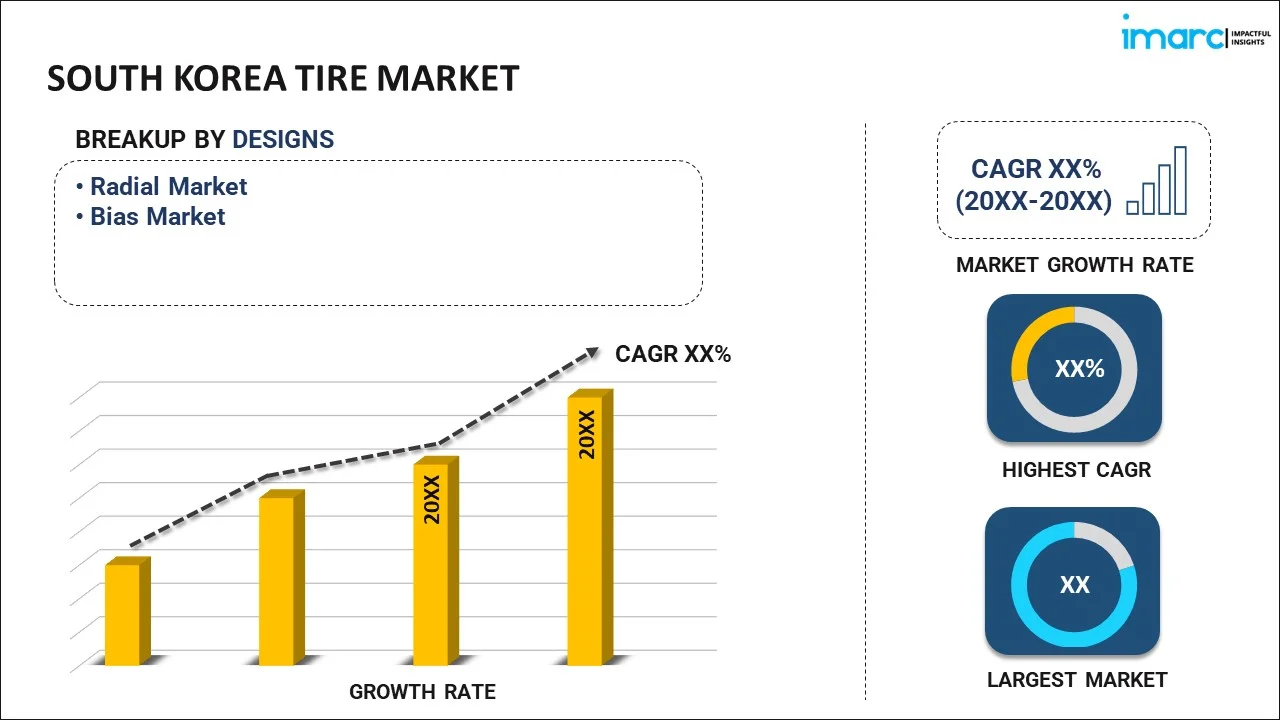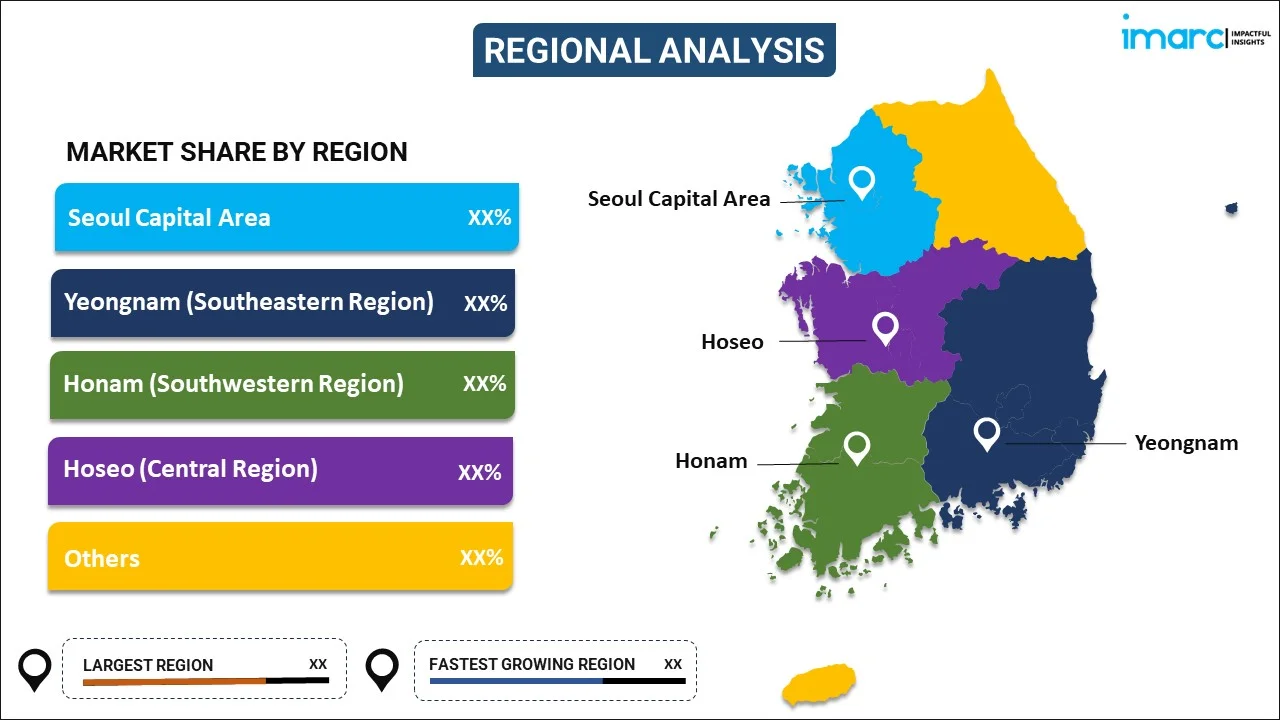
South Korea Tire Market Report by Design (Radial Market, Bias Market), End Use (OEM Market, Replacement Market), Vehicle Type (Passenger Cars, Light Commercial Vehicles, Medium and Heavy Commercial Vehicles, Two Wheelers, Three Wheelers, Off-The-Road (OTR)), Distribution Channel (Offline, Online), Season (All Season Tires, Winter Tires, Summer Tires), and Region 2024-2032
Market Overview:
South Korea tire market size is projected to exhibit a growth rate (CAGR) of 5.00% during 2024-2032. Continuous technological advancements and new product launches by leading manufacturers are primarily driving the market growth across the country.
|
Report Attribute
|
Key Statistics
|
|---|---|
|
Base Year
|
2023 |
|
Forecast Years
|
2024-2032
|
|
Historical Years
|
2018-2023
|
| Market Growth Rate (2024-2032) | 5.00% |
A tire is a circular component of a vehicle consisting of a rim and compressed air, crafted from diverse materials like rubber, wire, cotton, glass, silica, carbon black, and steel. It is accessible in tubed and tubeless variants, featuring essential components like bead, bead filler, belts, body ply, inner liner, sidewall, and tread. Its primary functions include supporting the vehicle load, providing shock absorption, and managing forces during motion. This contributes to improved vehicle performance, enhanced mileage, and passenger safety. Additionally, it ensures grip, refines vehicle handling on inclines, and aids in braking. Widely utilized in passenger cars, two-wheelers, three-wheelers, off-the-road (OTR), and light, medium, and heavy commercial vehicles globally, the tire's widespread availability and low rolling resistance make it a crucial component in vehicular applications.
South Korea Tire Market Trends:
In South Korea, the tire market is propelled by a combination of technological innovation, automotive industry dynamics, and a focus on sustainable mobility. Additionally, the country's automotive sector, marked by robust manufacturing and innovation, contributes to the demand for advanced tire technologies, which is positively influencing the regional market. Besides this, the adoption of electric vehicles (EVs) and eco-friendly initiatives shapes tire trends, emphasizing fuel efficiency and reduced environmental impact, thereby acting as another significant growth-inducing factor. Moreover, government regulations promoting safety and environmental standards encourage tire manufacturers to invest in research and development for high-performance and eco-friendly tire solutions. This, in turn, is bolstering the market growth. South Korea's commitment to smart transportation and smart cities further influences tire market dynamics, with a growing emphasis on intelligent tire technologies that enhance vehicle performance and safety. Furthermore, as South Korea continues to be a hub for automotive excellence, the tire market in the country will reflect a convergence of innovation, environmental consciousness, and the evolving needs of the automotive landscape over the forecasted period.
South Korea Tire Market Segmentation:
IMARC Group provides an analysis of the key trends in each segment of the market, along with forecasts at the country level for 2024-2032. Our report has categorized the market based on design, end use, vehicle type, distribution channel, and season.
Design Insights:

- Radial Market
- Bias Market
The report has provided a detailed breakup and analysis of the market based on the design. This includes radial market and bias market.
End Use Insights:
- OEM Market
- Replacement Market
A detailed breakup and analysis of the market based on the end use have also been provided in the report. This includes OEM market and replacement market.
Vehicle Type Insights:
- Passenger Cars
- Light Commercial Vehicles
- Medium and Heavy Commercial Vehicles
- Two Wheelers
- Three Wheelers
- Off-The-Road (OTR)
The report has provided a detailed breakup and analysis of the market based on the vehicle type. This includes passenger cars, light commercial vehicles, medium and heavy commercial vehicles, two wheelers, three wheelers, and off-the-road (OTR).
Distribution Channel Insights:
- Offline
- Online
A detailed breakup and analysis of the market based on the distribution channel have also been provided in the report. This includes offline and online.
Season Insights:
- All Season Tires
- Winter Tires
- Summer Tires
The report has provided a detailed breakup and analysis of the market based on the season. This includes all season tires, winter tires, and summer tires.
Regional Insights:

- Seoul Capital Area
- Yeongam (Southeastern Region)
- Honam (Southwestern Region)
- Hoseo (Central Region)
- Others
The report has also provided a comprehensive analysis of all the major regional markets, which include Seoul Capital Area, Yeongam (Southeastern Region), Honam (Southwestern Region), Hoseo (Central Region), and Others.
Competitive Landscape:
The market research report has also provided a comprehensive analysis of the competitive landscape in the market. Competitive analysis such as market structure, key player positioning, top winning strategies, competitive dashboard, and company evaluation quadrant has been covered in the report. Also, detailed profiles of all major companies have been provided. Some of the key players include:
- Bridgestone Tire Sales Korea Ltd. (Bridgestone Corporation)
- Hankook Tire & Technology
- Kumho Tire Co. Inc.
- Nexen Tire Corporation
(Please note that this is only a partial list of the key players, and the complete list is provided in the report.)
South Korea Tire Market Report Coverage:
| Report Features | Details |
|---|---|
| Base Year of the Analysis | 2023 |
| Historical Period | 2018-2023 |
| Forecast Period | 2024-2032 |
| Units | US$ Million |
| Scope of the Report | Exploration of Historical and Forecast Trends, Industry Catalysts and Challenges, Segment-Wise Historical and Predictive Market Assessment:
|
| Designs Covered | Radial Market, Bias Market |
| End Uses Covered | OEM Market, Replacement Market |
| Vehicle Types Covered | Passenger Cars, Light Commercial Vehicles, Medium and Heavy Commercial Vehicles, Two Wheelers, Three Wheelers, Off-The-Road (OTR) |
| Distribution Channels Covered | Offline, Online |
| Seasons Covered | All Season Tires, Winter Tires, Summer Tires |
| Regions Covered | Seoul Capital Area, Yeongnam (Southeastern Region), Honam (Southwestern Region), Hoseo (Central Region), Others |
| Companies Covered | Bridgestone Tire Sales Korea Ltd. (Bridgestone Corporation), Hankook Tire & Technology, Kumho Tire Co. Inc., Nexen Tire Corporation, etc. (Please note that this is only a partial list of the key players, and the complete list is provided in the report.) |
| Customization Scope | 10% Free Customization |
| Report Price and Purchase Option | Single User License: US$ 3699 Five User License: US$ 4699 Corporate License: US$ 5699 |
| Post-Sale Analyst Support | 10-12 Weeks |
| Delivery Format | PDF and Excel through Email (We can also provide the editable version of the report in PPT/Word format on special request) |
Key Questions Answered in This Report:
- How has the South Korea tire market performed so far and how will it perform in the coming years?
- What has been the impact of COVID-19 on the South Korea tire market?
- What is the breakup of the South Korea tire market on the basis of design?
- What is the breakup of the South Korea tire market on the basis of end use?
- What is the breakup of the South Korea tire market on the basis of vehicle type?
- What is the breakup of the South Korea tire market on the basis of distribution channel?
- What is the breakup of the South Korea tire market on the basis of season?
- What are the various stages in the value chain of the South Korea tire market?
- What are the key driving factors and challenges in the South Korea tire?
- What is the structure of the South Korea tire market and who are the key players?
- What is the degree of competition in the South Korea tire market?
Key Benefits for Stakeholders:
- IMARC’s industry report offers a comprehensive quantitative analysis of various market segments, historical and current market trends, market forecasts, and dynamics of the South Korea tire market from 2018-2032.
- The research report provides the latest information on the market drivers, challenges, and opportunities in the South Korea tire market.
- Porter's five forces analysis assist stakeholders in assessing the impact of new entrants, competitive rivalry, supplier power, buyer power, and the threat of substitution. It helps stakeholders to analyze the level of competition within the South Korea tire industry and its attractiveness.
- A competitive landscape allows stakeholders to understand their competitive environment and provides an insight into the current positions of key players in the market.
Need more help?
- Speak to our experienced analysts for insights on the current market scenarios.
- Include additional segments and countries to customize the report as per your requirement.
- Gain an unparalleled competitive advantage in your domain by understanding how to utilize the report and positively impacting your operations and revenue.
- For further assistance, please connect with our analysts.
 Inquire Before Buying
Inquire Before Buying
 Speak to an Analyst
Speak to an Analyst
 Request Brochure
Request Brochure
 Request Customization
Request Customization




.webp)




.webp)












